When it comes to meat products, terms like “cured” and “uncured” are commonly used, leaving many consumers scratching their heads as to what they mean. Does one type of meat offer health benefits over the other? Is one better for cooking or preserving than the other? Understanding the differences between cured and uncured meat products is essential for informed decision-making regarding purchasing and consuming food.
Suppose you’re curious about which type of meat to choose. In that case, this article will discuss the differences between cured and uncured meat and their respective health benefits, cooking techniques, and preservation methods. Keep reading to learn more about the differences between cured vs uncured meat and which is right for you.
What is Cured Meat?

As a meat aficionado, I’ve always been fascinated by curing meat. Cured meat is a type of meat that has been preserved and enhanced in flavor through a process of salting, drying, or smoking. This age-old technique has been used for centuries, with each culture having its unique take. So, what exactly is cured meat?
Nowadays, curing meat has evolved into an art form involving various techniques and ingredients. Some of the most popular types of cured meat include prosciutto, salami, bacon, and ham. Every kind of cured meat combines ingredients and curing techniques, resulting in a distinct flavor and texture.
One of the key ingredients in curing meat is salt. Salt plays an essential role in the curing process by extracting moisture from the meat, which helps to prevent bacterial growth. Different types of salt can be used in curing meat, including sea salt, kosher salt, and curing salt. Curing salt, also known as Prague powder or pink salt, is a mixture of sodium nitrite and salt commonly used in curing meat to prevent the growth of harmful bacteria.
Another important ingredient in curing meat is nitrates. Nitrates are naturally occurring compounds found in vegetables and can be added to meat during curing. Nitrates help to preserve meat by preventing the growth of bacteria that can cause spoilage. They also give cured meat its characteristic pink color and distinct flavor.
In addition to salt and nitrates, other ingredients and techniques can add flavor and texture to cured meat. For example, herbs and spices can be added to the curing mixture to impart a unique flavor. Smoking is another technique that can enhance the flavor of cured meat. Smoking meat over low heat can take on a smoky flavor and aroma highly prized by meat lovers.
4 Popular Types of Cured Meat
Here, we will explore the four most popular types of cured meat and what makes them so special.
Hot dogs
Hot dogs are a type of sausage that has been cured and smoked, giving them a distinctive flavor. They are a popular food in the United States and are often served at sporting events and barbecues. Hot dogs are made from a combination of beef, pork, and chicken and are seasoned with a blend of spices, including paprika, garlic, and mustard. They can be served on a bun with various toppings, including ketchup, mustard, onions, and relish.
Ham
Ham has cured meat made from a pig’s hind leg. It is often served as a holiday meal and is popular for sandwiches and breakfast dishes. The curing process involves soaking the meat in a brine solution that contains salt, sugar, and various spices. The ham is then smoked to give it a rich, smoky flavor. There are many different types of ham, including country ham, city ham, and prosciutto.
Bacon
Bacon is a type of cured meat that is made from pork belly. It is a popular breakfast food in the United States and is often used as a topping for burgers and sandwiches. The curing process involves coating the pork belly in a mixture of salt, sugar, and various spices. The bacon is then smoked to give it its distinctive flavor. There are many different types of bacon, including Canadian bacon, which is made from the loin of a pig.
Pepperoni
Pepperoni is a type of cured sausage made from beef and pork. It is a popular topping for pizzas and is often used in Italian dishes. The curing process involves fermenting the meat with lactic acid bacteria, which gives it its distinctively tangy flavor. The pepperoni is then smoked to give it a rich, smoky flavor.
What is Uncured Meat?
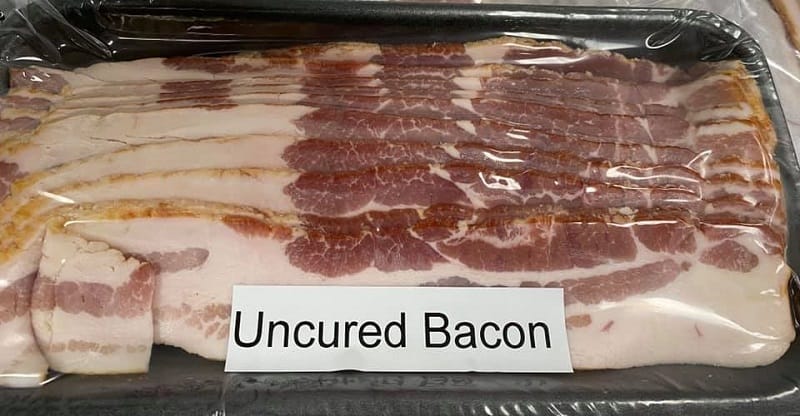
I’ve come across the term “uncured meat” more than a few times, and to be honest, I wasn’t entirely sure what it meant at first. So, I did a bit of research, and here’s what I found out. Uncured meat is meat that hasn’t been treated with synthetic nitrates or nitrites during the curing process. Traditional meat curing processes often use these additives to preserve the meat and give it a distinct flavor and color.
Now, you might be wondering if uncured meat is safe to eat. The answer is yes, as long as it’s handled and cooked properly. Just like with any other type of meat, it’s essential to make sure it’s been stored at the correct temperature and cooked to the appropriate temperature to ensure it’s safe to eat.
One thing to keep in mind is that uncured meat may have a slightly different taste than its cured counterpart. It may not have the same depth of flavor or color, but that doesn’t mean it’s any less delicious. Many people prefer the taste of uncured meat because it has a more natural and authentic flavor.
Plenty of options are available if you’re looking to try out some recipes with uncured meat. Uncured bacon, for example, can be used in various dishes such as burgers, salads, and pasta dishes. Uncured ham can be used in sandwiches, omelets, and quiches. And uncured sausages can be grilled or roasted and served with your favorite sides.
3 Popular Types of Uncured Meat
Here are three popular types of uncured meat that I’ve tried and can highly recommend.
Uncured Hot Dogs
I used to love hot dogs, but after learning about the harmful effects of nitrates and other additives commonly found in traditional hot dogs, I decided to try uncured hot dogs. I was pleasantly surprised by how much I enjoyed the taste and texture of these hot dogs, which were made with high-quality, natural ingredients. They had a milder flavor than traditional hot dogs but were still satisfying. Plus, they gave me peace of mind knowing I wasn’t consuming harmful additives.
Uncured Ham
Ham is another processed meat that often contains nitrates and other additives. On the other hand, Uncured ham is made using natural curing processes or alternative methods like sea salt and celery juice. I’ve found that uncured ham has a slightly different texture than traditional ham, but the flavor is just as delicious. It’s perfect for sandwiches or as a main dish for dinner.
Uncured Bacon
Bacon is a staple in many households, but the traditional version is often loaded with nitrates and other additives. On the other hand, uncured bacon is made using natural curing processes or alternative methods like sea salt and sugar. I’ve found that uncured bacon has a slightly different texture than traditional bacon, but the flavor is just as delicious. It’s perfect for breakfast, adding to salads or sandwiches, or incorporating into a variety of recipes.
Similarities Between Cured And Uncured Meat
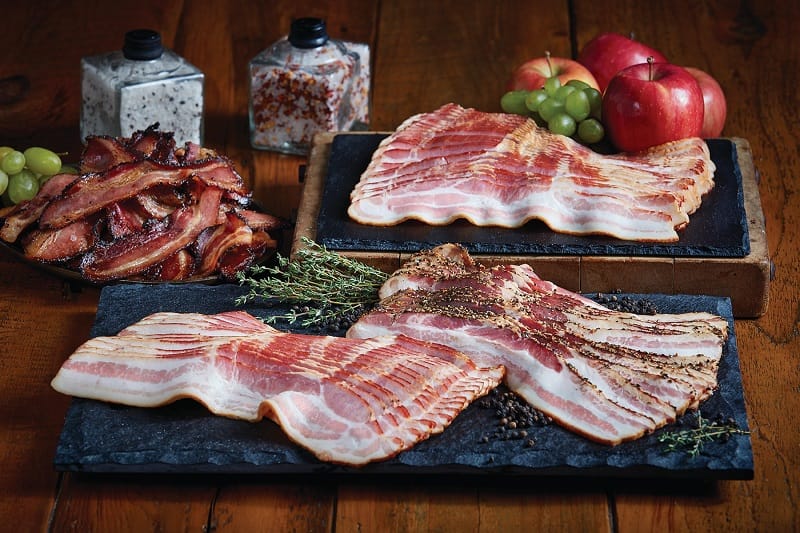
I have always been curious about the differences between cured and uncured meat, and I discovered that while there are some differences, there are also many similarities.
First, let’s define what cured and uncured meat are. Cured meat has been preserved using salt, nitrates, or other curing agents. This preservation process gives the meat a distinct flavor and extends its shelf life. On the other hand, uncured meat has not been treated with these curing agents and is generally considered to have a fresher taste.
Now, onto the similarities. Both cured and uncured meat is excellent sources of protein, iron, and other essential nutrients. They also come from animals like beef, pork, and chicken. In terms of cooking, both types of meat can be grilled, roasted, or sautéed to perfection.
Another similarity between cured and uncured meat is that they come in various cuts. You can find cured and uncured options, whether you prefer a juicy steak or a tender pork chop. Additionally, both types of meat can be used in a variety of dishes, such as stews, stir-fries, and sandwiches.
What Is The Main Difference Between Cured vs Uncured
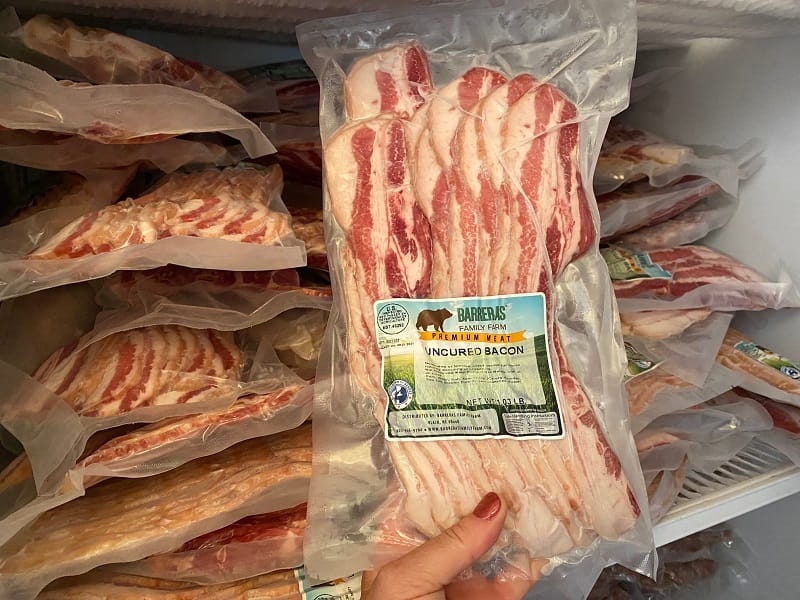
The main difference lies in the preservation process when it comes to cured vs. uncured meats. Cured meats are preserved using artificial preservatives, while uncured meats are preserved using natural sources such as celery powder. While cured meats have a longer shelf life, some prefer the natural process and more nuanced flavor of uncured meats. Additionally, uncured meats retain more water due to the difference in preservatives.
While both types of meat have unique qualities, it’s important to understand these differences to decide which type of meat to consume.
Shelf Life
Cured meats, treated with various curing agents and preservatives, can last for months or even years when stored properly. On the other hand, Uncured meats have a much shorter shelf life and should be consumed within a few days of purchase. This is because they lack the preservatives that help prevent spoilage.
Color
Cured meats often have a distinct pinkish-red hue, which is a result of the curing process. This color is caused by the reaction between the curing agents and the meat’s natural proteins. On the other hand, Uncured meats have a more natural color that varies depending on the type of meat.
Chemical Preservatives
Cured meats contain various chemical preservatives, such as nitrates and nitrites, which are used to prevent the growth of harmful bacteria and extend their shelf life. These preservatives have been linked to health concerns such as cancer, which is why many people opt for uncured meats instead.
Uncured meats are not treated with these chemical preservatives but are preserved using natural methods such as salt and vinegar.
Texture
There is a noticeable difference in the texture of cured vs. uncured meats. Cured meats are often firmer and denser, while uncured meats are more tender and juicy. This is due to the curing process, which can cause the meat to lose moisture and become dense.
Rich Flavor
Uncured meat is known for its rich and natural flavor. Unlike cured meat, which has been treated with various additives and preservatives, uncured meat is not altered. This means that you can taste the true essence of the meat without any interference from artificial flavors.
Is Cured Meat Saltier Than Uncured Meat?
The answer is yes. Cured meat is typically saltier because salt is used as a preservative. The curing process involves adding salt to the meat, which draws out the moisture and prevents bacteria growth. This results in a longer shelf life for the meat but also makes it saltier.
Cured vs. Uncured. Which is Healthier?
While uncured meat may seem healthier because it doesn’t contain additives or preservatives, it’s important to note that it can still be high in saturated fat and calories. On the other hand, cured meat may contain more sodium but can also be lower in fat and calories.
Read more:
What Is The Impact Of Curing On The Nutritional Value Of Meat?
One of the main concerns with curing meat is the amount of added sodium. Salt is a key ingredient in curing, and consuming too much sodium can lead to high blood pressure and other health issues. However, it’s important to note that not all cured meats are high in sodium. Some varieties, such as prosciutto or serrano ham, are relatively low in sodium compared to other types of cured meat.
Another concern is the use of nitrates in the curing process. Nitrates help preserve meat and give it that characteristic pink color. However, there is some debate over whether nitrates harm our health. Some studies have linked them to an increased risk of cancer, while others argue that the amount used in cured meats is too small to be a concern.
When it comes to the nutritional value of cured meat, there are some differences compared to fresh meat. Curing can increase the protein content of meat and certain vitamins and minerals. For example, cured ham is a good source of thiamin, a B vitamin that helps the body convert food into energy.
However, curing can also lead to a loss of certain nutrients. For example, the high temperatures used in smoking can break down some of the B vitamins in meat. Additionally, the longer meat is cured, the more nutrients it can lose.
Are Natural Flavorings More Effective Than Artificial Preservatives In Enhancing Taste?
Different options are available for flavorings and preservatives when it comes to enhancing the taste of cured and uncured meat. Some people prefer natural flavorings, while others opt for artificial preservatives. However, in terms of effectiveness in improving taste, scientific evidence suggests that natural and artificial ingredients can have similar results.
Moreover, it’s worth noting that natural flavorings do not necessarily mean healthier or safer. For instance, naturally occurring in some vegetables and added to cured meats for preservation, nitrites can potentially form carcinogenic compounds called nitrosamines. Therefore, weighing the pros and cons of different flavor-enhancing methods and choosing accordingly is essential.
Cured Vs Uncured Bacon?
While both types of bacon go through a curing process to slow down fat oxidation, which reduces rancidity, the natural curing process of uncured bacon leaves it in a more natural, green state, resulting in a stronger pork belly flavor and saltier taste. Many people prefer uncured bacon due to the absence of synthetic nitrates and nitrites, which have been associated with health concerns. Ultimately, whether one prefers cured or uncured bacon comes down to personal preference and dietary restrictions.
Cured Vs Uncured Ham?
When purchasing ham, consumers may come across the terms “cured” and “uncured” and wonder what the difference is. Essentially, cured ham uses chemical preservatives, while uncured ham relies on natural salts and flavorings.
However, it is essential to note that both types of ham are technically cured – the difference is in the method. Uncured ham goes through a more natural curing process and contains no nitrates or nitrites. It is fresher and may be preferred as a more realistic option. Cured ham, on the other hand, uses synthetic nitrite preservatives to preserve the meat.
While both types of ham are preserved, the distinction between them may be less useful than previously thought. Foodservice operators may want to offer both options to cater to various customer preferences. (See more: here)
Cured Vs Uncured Hot Dogs?
The difference comes down to the ingredients used for preservation. While some people prefer the natural preservation of uncured hot dogs, others may opt for the longer shelf life of cured hot dogs. In the end, it all comes down to personal preference. But regardless of choice, it’s important always to read the label and be aware of any potential health concerns associated with processed meats.
Are There Any Health Benefits Of Eating Uncured Meat?
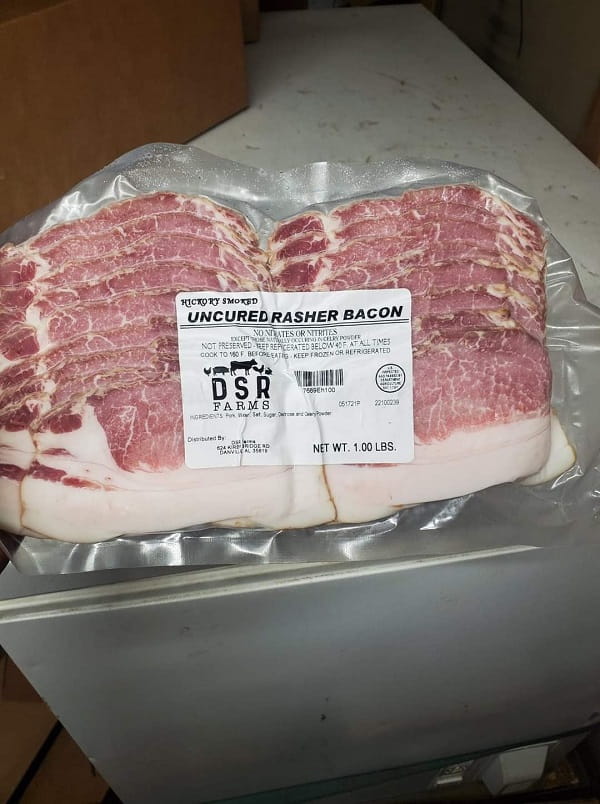
Through my research, I’ve found that there are indeed some health benefits to eating uncured meat.
One of the main benefits of eating uncured meat is that it is free from these artificial preservatives. Nitrates and nitrites have been linked to health concerns such as cancer and heart disease. By choosing uncured meat, you can avoid these potential risks.
Another benefit of uncured meat is its often more natural flavor. You get a cleaner taste without the added preservatives that allow the meat’s natural flavors to shine. This can make for a more enjoyable and satisfying eating experience.
In addition, uncured meat is often sourced from animals not treated with antibiotics or growth hormones. This means that you are consuming a more natural and pure product. These additives can also negatively impact our health, so by choosing uncured meat, you can also avoid these potential risks.
Of course, it’s important to note that while eating uncured meat has some health benefits, it is still meat and should be consumed in moderation. Too much red meat consumption has been linked to health concerns such as heart disease and cancer. As with any food, it’s important to make sure you are consuming a balanced diet.
Is Uncured Meat Safe To Eat?
Uncured meat has become popular for those who want to avoid the potentially harmful chemicals in cured meats. But is it safe to eat? According to scientific studies, uncured meats are a safe option when consumed in moderation. While cured meats use chemical preservatives like sodium nitrite and nitrate, uncured meats rely on natural salts and flavorings for preservation. This natural preservation process does not use synthetic chemicals, which could be harmful if overconsumed.
However, if not stored properly, bacteria like listeria and salmonella can grow on uncured meats. So, it’s essential always to follow safe handling and storage practices. Overall, as long as it’s enjoyed in moderation and handled and stored properly, uncured meat can be a delicious and safe option.
How Long Does It Take To Cure Meat Properly?
When it comes to curing meat, it’s important to know that the process can take anywhere from a few days to several months, depending on the type of meat and curing method used. For example, a small duck breast may only take 4-5 weeks to cure, while large cuts of pork could take several months.
It’s crucial to leave ample time for the curing process and to take into account factors such as the type of meat, texture, and brine strength. Wet curing involves a liquid brine, while dry curing does not, but both processes require patience and attention to detail in order to achieve the desired result.
Regardless of the method chosen, salt is generally used to cure meats by drawing water out of cells and depriving pathogens of the moisture they need to grow. Despite the time and effort involved, properly cured meat can be a delicious and rewarding addition to any dish.
What’s The Difference Between Synthetic Nitrates And Natural Sources In Curing Agents?
First, let’s define what we mean by synthetic nitrates. These are chemical compounds that are derived from nitrogen and are commonly used in processed meats as a way to preserve them and add flavor. They are often referred to as “curing salts” and include sodium nitrate and sodium nitrite. On the other hand, natural sources of nitrates are found in vegetables like celery, beets, and spinach. These natural sources are often used in “uncured” meats, like those labeled nitrate-free.
Synthetic nitrates have been linked to health concerns like cancer, while natural sources have not. The reason for this is that when synthetic nitrates are heated, they can form compounds called nitrosamines, which are carcinogenic in animal studies. However, it’s important to note that the number of synthetic nitrates used in processed meats is highly regulated and kept at safe levels. Some argue that the natural sources of nitrates can also form nitrosamines when heated, although at much lower levels.
But it’s not just about health concerns. Synthetic nitrates have also been criticized for their impact on flavor. While they add a distinct taste to cured meats, some argue they can be overpowering and artificial. On the other hand, natural sources provide a more subtle flavor that complements the meat without overwhelming it.
It’s ultimately up to the consumer to decide which cured meat they prefer. If you’re concerned about health risks, opting for nitrate-free or naturally cured meats is a safe bet. But synthetic nitrates may be the way to go if you’re a fan of the distinct flavor of cured meats and aren’t overly concerned about health risks.
What Are Some Ways To Prepare Cured And Uncured Meat In Meals?
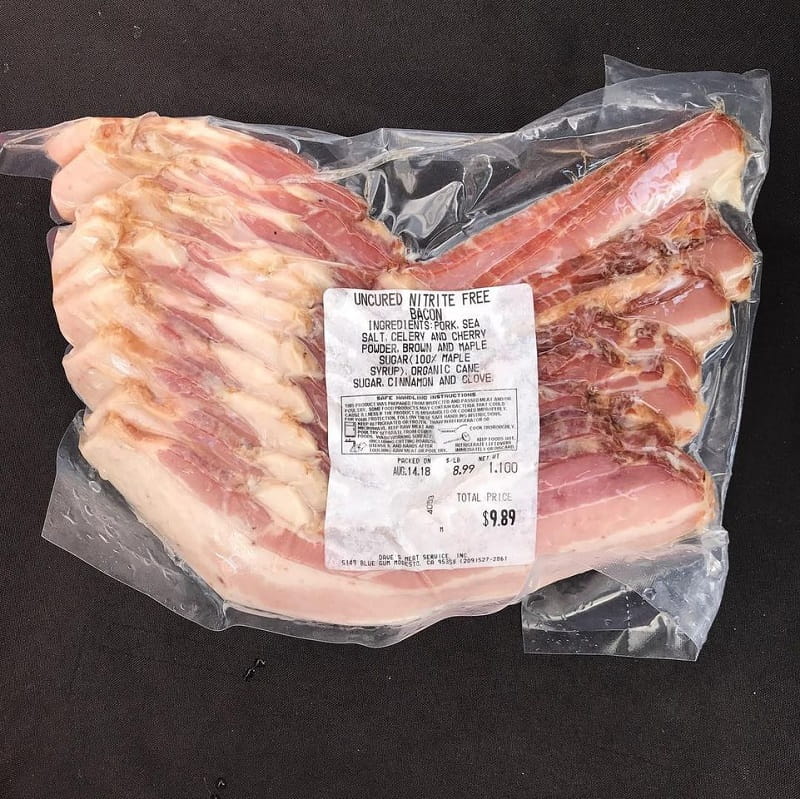
If you’re like me and want to expand your meat-cooking repertoire, here are some ways to prepare cured and uncured meat in meals.
One way to prepare cured meat in meals is to add it to salads. You can chop up some crispy bacon or thinly sliced prosciutto and toss it with fresh greens, vegetables, and a vinaigrette dressing for a delicious and satisfying salad. Another option is to incorporate cured meat into quiches or frittatas. The salty flavors of the meat add depth to the eggs and cheese, making for a tasty breakfast or brunch option.
One way to prepare uncured meat in meals is to marinate it. Marinating helps to tenderize the meat and infuse it with flavor. You can make a simple marinade with oil, vinegar, herbs, and spices and let your meat soak in it for several hours before grilling, sautéing, or roasting it. Another option is to slow-cook your meat in a crockpot or Dutch oven. This method allows the meat to cook slowly and become tender and juicy.
In addition to these methods, you can prepare cured and uncured meat in meals by using them as the main protein source in dishes like stews, casseroles, and stir-fries. You can also experiment with different cooking techniques like smoking, braising, and searing to add depth and complexity to your meat dishes.
Common Misconceptions About Cured And Uncured Meat
There are many misconceptions about cured and uncured meat that I feel compelled to clear up. So, let’s dive in and separate fact from fiction.
Misconception #1: All cured meat is bad for you.
This is not true. While it’s true that some cured meats, like bacon and salami, are high in sodium and nitrates, not all cured meats are created equal. Some cured meats, like prosciutto and serrano ham, are relatively low in sodium and nitrates and can be a healthy addition to your diet in moderation.
Misconception #2: Uncured meat is always healthier than cured meat.
While it’s true that uncured meat doesn’t contain any added nitrates or nitrites, that doesn’t necessarily make it healthier than cured meat. Many uncured types of meat are still processed and may contain other additives and preservatives. Additionally, some uncured meats may be less safe than their cured counterparts if they aren’t properly handled and stored.
Misconception #3: Cured meat is always salty.
While many cured types of meat are indeed salty, that’s not always the case. As I mentioned, some cured meats are relatively low in sodium and can be a healthy addition to your diet. Additionally, the saltiness of cured meat can be balanced out by pairing it with other flavors, like sweet fruits or tangy cheeses.
Misconception #4: All cured meat is created equal.
This is not true. The quality of cured meat can vary greatly depending on a number of factors, including the quality of the meat used, the curing process, and the skill of the person doing the curing. When it comes to cured meat, it’s important to research and buy from a reputable source.
Misconception #5: Curing meat is a difficult process that professionals should only attempt.
While it’s true that curing meat takes some skill and knowledge, it’s not an impossible task for the home cook. You can easily cure your meat at home with some basic equipment and a little practice. However, following proper safety guidelines and always using fresh, high-quality meat is important.
FAQs About Cured vs Uncured
Can Cured Meat Be Part Of A Healthy Diet?
While it’s true that cured meats often contain high salts and nitrates, which can be harmful when consumed in excess, healthier options, such as uncured or naturally cured meats, are available. Additionally, processed meats like bacon and deli meats should be limited due to their increased cancer risk, but when consumed in moderation, they can still be enjoyed as part of a balanced diet.
How Long Can be Cooked Bacon Sit Out?
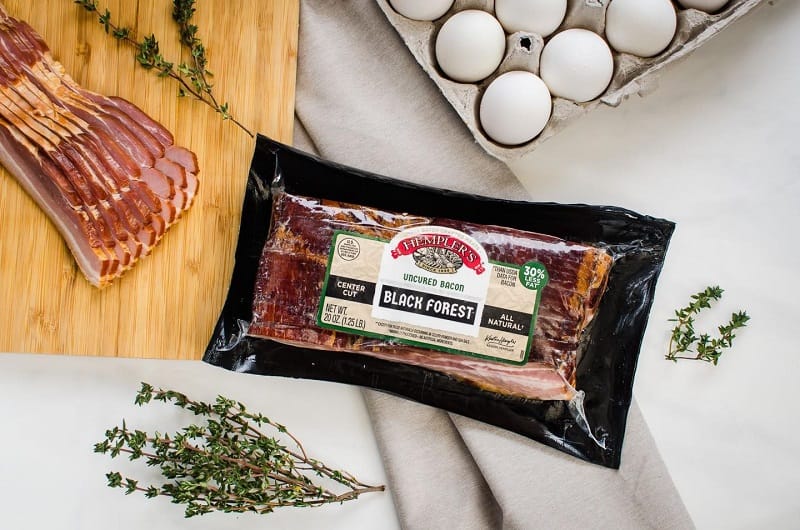
Cooked bacon should not be left at room temperature for more than two hours. If the room temperature is above 90°F, the bacon will only be good for one hour before it becomes unsafe to eat. Some experts even suggest that cooked bacon left at room temperature for more than three hours may become a breeding ground for harmful bacteria. So, if you have any leftover cooked bacon, refrigerate it within two hours to prevent bacterial growth.
What Is Nitrate, And Why Is It Commonly Used In Cured Meat?
Nitrate is a natural chemical found in the soil, air, and water, and it is commonly used in curing meats. When added to cured meat, nitrates are converted into nitrites, which help preserve the meat by inhibiting bacterial growth.
Nitrites are responsible for improving meat quality and safety and giving cured meats distinctive flavor and color. Although nitrates and nitrites are potentially cancer-causing compounds, they are still used in small amounts in many cured meat products to maintain their safety and delicious flavor. Overall, nitrate is important in curing and helps create the tasty cured meats many people enjoy.
Conclusion
In conclusion, the debate between cured vs uncured meat ultimately comes down to personal preference and individual health concerns. While both types of meat have pros and cons, some people may prefer the taste and convenience of cured meats, while others may choose to avoid them for health reasons. Whether you prefer the flavor and convenience of cured meats or the natural preservation methods of uncured meats, the key is to make informed choices and enjoy your food in moderation.
References:
- https://timesofindia.indiatimes.com/life-style/health-fitness/diet/health-benefits-of-smoked-and-cured-meat/articleshow/15401559.cms
- https://www.themeateater.com/wild-and-whole/learn-cooking-technique/everything-you-need-to-know-about-salt-curing-meat
- https://nchfp.uga.edu/publications/nchfp/lit_rev/cure_smoke_cure.html

Hey readers! Chip Holland here, and I’m a Manager of this website. My passion for writing about it only matches my passion for BBQ. Follow my blog for mouth-watering recipes, tips, and tricks for the perfect smoke, grill, and BBQ. I’m sure you won’t be disappointed!
